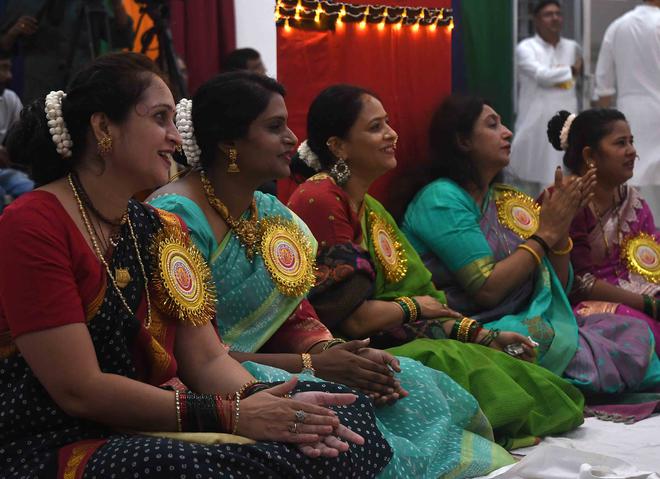“He’s a Navrathri phenomenon,” says Vandana Agarawal, a Bangalorean who has lived in the city for 25 years. She is talking about Gopi Chettan who appears every Navrathri in front of the Sarada Devi temple in Mattancherry to make “bondas” for devotees. “It’s an offering,” says a passerby, enjoying the snack. Gopi does good business selling the fresh delectable bondas for the nine-days of the festival.
Kolkata-based Latu Patro has arrived in Kochi on the invitation of the 56-year-old Kerala Banga Samskriti Sangha. He will play the Dhaki drums for the Bengali celebration of Maha Sashti (October 1). Tapan Kumar Jana, the idol maker, came to the city a month ago along with his wife Suchitra and brother Jyotirmoy. Apart from Kochi, they have orders for idols from North Indian communities in Thriuvanathapuram, Kanyakuamri and Kozhikode. Another visitor from Kolkata is Abhijeet Kohar, who has been invited by the North Indian Association of Kochi. Along with his troupe, he will perform devotional numbers at the Association premises at Udaynagar
“I have a stock of 3000 chanya choli or lehenga and blouses for the Navratri dances,” says Nitin Nathwani, owner of Jalarams, a store that stocks “fancy items” in Mattancherry and one of the main suppliers of the Gujarati lehenga to stores in Kerala. “I have orders from Munnar, Guruvayur, Kasaragod and from Thrikakkara and Thripunithura.”
The 10,000-strong Gujarati community in Kochi is looking forward to the festivities after a gap of “two very tough years”. Hema Mevani has hand-painted and decorated over 300 earthenware pots for the festival. “The pot represents the goddess,” says Hema who came to Kochi 25 years ago and established a store catering to the community’s specific needs. “She is invoked and a lamp is lit inside the pot, symbolising divine energy. We dance around her and pray for nine days.”
Yoga teacher Sonal Joshi has been mobilising girls and women to practice the dandiya, which they will perform at three Gujarati temples in Mattanchery — Dariyastha, SamudriMata and Mahadev Temple — during this time.

This year, the festival has been well thought-out, says Praditpti Jayaram, who runs the popular rental store Chamayam. She is going by bookings over the past one. From Gujarati lehengas to Rajasthani ones, “with more flare”, she has stocked dandiya sticks, jewellery and accessories like pots, umbrellas and drums to go with the settings. “I have 15 to 20 pairs of each style, with the prices starting at Rs 350.”
The new entrants to the city’s growing Navaratri celebrations are the staff of the Naval and Coast Guard establishments. Since these are confined to cantonments such as Naval Base (Katari Bagh), Dronacharya (Fort Kochi), Mahavir Enclave and Coast Guard in Mundamveli, makeshift bazaars that sell the necessary items are cropping up. At Mundamveli, where a majority of the Hindi-speaking community live, little stores flaunt the glittering red chunri (cloth) offered to the Goddess, brass lamps, earthenware pots, special foods for fasting and more. “ We are almost 2,500 strong, associated with the cantonment in Mundamveli. The idols for the Naval celebrations were made by idol makers who came from Bengal carrying clay and soil from the banks of the Ganges,” says Rakesh Bahadur Singh, one of the organisers.

Pavanjeet Sethi, president of the Ladies Wing of the North Indian Association, says that they have decided to celebrate with a bang. Each day of the festival will be meant for one State and dresses and delicacies will pertain to that. On the Maha Saptami (October 2), each participant will make two to three kilos of special food for the Goddess. “We will have Chapan Bhog or 56 varieties of dishes as offering. These will be shared as prasad,” says Pavanjeet.








